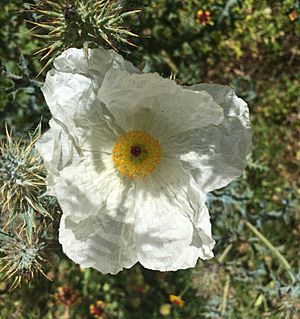White prickly poppy facts for kids
Quick facts for kids White prickly poppy |
|
|---|---|
 |
|
| White prickly poppy | |
| Scientific classification | |
| Genus: |
Argemone
|
| Species: |
albiflora
|
The white prickly poppy (scientific name: Argemone albiflora) is a cool plant with pretty white flowers. People also call it the bluestem prickly poppy or the Texas prickly poppy. It's a small plant that stands up straight. Its flowers have a yellow liquid inside, like sap. The plant has deep roots and bright yellow or red parts inside its flowers called stamens. You can easily spot this plant because it has sharp prickles on its stem and leaves! As the flower grows, some parts called sepals fall off. You'll often find it growing in dry areas of the southern Midwest, especially along roads and in places where the ground has been disturbed. Long ago, Native American people thought this plant was very special and used it for many things, including medicine. Its leaves are simple, meaning they are not divided into smaller parts.
Contents
Where It Grows
The white prickly poppy grows in many places. You can find it from east Texas all the way to northern Arkansas and southern Missouri. It also naturally grows in parts of Southern California's High Desert, like near Twentynine Palms.
Where It Lives
The white prickly poppy can live for one or two years. It often grows in groups in sandy or rocky soil. You might see this plant growing along fences, next to roads, near railroad tracks, or on hills. It also likes to grow in pastures where animals have grazed a lot.
What It Looks Like
This plant stands up tall and has deep roots. It has sharp prickles all over it. Its white flowers have many yellow and red stamens inside. The flowers grow either by themselves or in small groups at the top of the plant.
The leaves are a grayish-green color and can be long, from 2 to 10 inches. They are shaped like a spear or an egg. The lower leaves are deeply cut, almost to the middle vein. The leaves higher up on the plant are not as deeply cut. The top of the leaf feels smooth, but it has a few prickles along its middle vein. The bottom of the leaf is spiny along the middle and main veins.
Flowers and Seeds
The flowers of the white prickly poppy have 3 long sepals (leaf-like parts that protect the bud). They also have 6 petals that are shaped like an egg or are almost round. The edges of the petals are a bit rough. The center of the flower has one chamber with many tiny parts that will become seeds. It also has a purple part called a stigma, which has 3 to 5 lobes.
The fruit of this plant is a spiny capsule. This capsule opens up at the top to release the seeds. The seeds themselves are brownish-black.
How People Use It
The oil from the white prickly poppy seeds was used during World War II. It was a good lubricant, which is a slippery substance that helps machines move smoothly. Scientists found that the seeds have about 25.8% oil. This is similar to the amount of oil found in soybeans! People also grow the white prickly poppy because it's a pretty plant for gardens.
Food Source
Most animals, like cattle, usually avoid eating this plant. This is because it's very prickly and doesn't have much nutrition for them. However, the seeds are the most nutritious part of the plant. Birds like quails and doves eat these seeds because they are high in oil. Each flower makes a lot of seeds, so it's a reliable food source for these birds.
Medicinal Uses
The white prickly poppy produces a yellow sap, or latex. Native American people used this sap for many different health problems. Some groups, like the Comanches, respected the plant so much that they would make offerings to it when they harvested it. They would use the yellow sap to remove warts, treat cold sores, and help with other skin issues.
People could also make a special drink from the flower. This drink helped with stuffy noses from colds or the flu. The seeds could be used to make someone vomit if they ate something bad. They could also work as a laxative (to help with digestion) or even a mild calming medicine. The whole plant could be used to help with bladder infections, prostate pain, or even bad headaches like migraines. A wash made from the plant's "tea" could help heal sunburns or scraped skin. In some important ceremonies, people would smoke the plant. This could make them feel happy and a little sleepy. But it's very important to know that if this plant is not used correctly, it can be very harmful.

